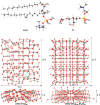Modeling the Interaction of Coronavirus Membrane Phospholipids with Photocatalitically Active Titanium Dioxide
- PMID: 37343210
- PMCID: PMC10316400
- DOI: 10.1021/acs.jpclett.3c01372
Modeling the Interaction of Coronavirus Membrane Phospholipids with Photocatalitically Active Titanium Dioxide
Abstract
The outbreak of viral infectious diseases urges airborne droplet and surface disinfection strategies, which may rely on photocatalytic semiconductors. A lipid bilayer membrane generally encloses coronaviruses and promotes the anchoring on the semiconductor surface, where, upon photon absorption, electron-hole pairs are produced, which can react with adsorbed oxygen-containing species and lead to the formation of reactive oxygen species (ROSs). The photogenerated ROSs may support the disruptive oxidation of the lipidic membrane and pathogen death. Density functional theory calculations are employed to investigate adsorption modes, energetics, and electronic structure of a reference phospholipid on anatase TiO2 nanoparticles. The phospholipid covalently bound on TiO2, engaging a stronger adsorption on the (101) than on the (001) surface. The energetically most stable structure involves the formation of four covalent bonds through phosphate and carbonyl oxygen atoms. The adsorbates show a reduction of the band gap compared with standalone TiO2, suggesting a significant interfacial coupling.
Conflict of interest statement
The authors declare no competing financial interest.
Figures





References
-
- Wolfel R.; Corman V. M.; Guggemos W.; Seilmaier M.; Zange S.; Muller M. A.; Niemeyer D.; Jones T. C.; Vollmar P.; Rothe C.; Hoelscher M.; Bleicker T.; Brunink S.; Schneider J.; Ehmann R.; Zwirglmaier K.; Drosten C.; Wendtner C. Virological assessment of hospitalized patients with COVID-2019. Nature 2020, 581, 465–469. 10.1038/s41586-020-2196-x. - DOI - PubMed
-
- Cheng H. Y.; Jian S. W.; Liu D. P.; Ng T. C.; Huang W. T.; Lin H. H. Contact Tracing Assessment of COVID-19 Transmission Dynamics in Taiwan and Risk at Different Exposure Periods Before and After Symptom Onset. JAMA Intern. Med. 2020, 180, 1156–1163. 10.1001/jamainternmed.2020.2020. - DOI - PMC - PubMed
MeSH terms
Substances
LinkOut - more resources
Full Text Sources
Miscellaneous

